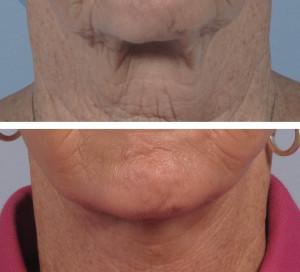What works to tighten a sagging neck?
There are many options available for neck tightening, but only a handful of them actually work. If you have moderate to severe looseness and sagging under your chin due to stretched skin and muscle, then necklift surgery is the most effective treatment.
If you have a very loose neck and you are not interested in surgery, you’ll have to accept a partial improvement with the minimally-invasive neck tightening options. But if you don’t have a severe so-called “turkey wattle”, you will likely be satisfied with a non-surgical neck procedure.
Most of my patients who are looking for neck-tightening in New York have mostly decided if they are willing to undergo surgery or a non-surgical procedure before they come in for a consultation. Below I explain the range of surgical and non-surgical neck-lift options.
Ways to tighten your neck without surgery
Neck exercises – There are several books and courses on neck and “facial firming exercises” that are aimed at tightening up the skin by toning your face and neck muscles. You can even find specialized neck toning machines that act as a gym for your neck. There is no reliable clinical evidence that these exercises make you look younger or tighten your neck.
Neck Botox – Botox can help with mild neck bands, especially if you have a thin neck and are just seeing some early, slight muscle bands at the bend of your neck. The results may be subtle and will typically last for a few months at a time by decreasing the ability of that section of your neck muscle (platymsa muscle) to contract.
Neck liposuction – This can appear to tighten your neck if you have a fat pocket under your chin. It works best if don’t have excessively loose skin and neck muscle. Neck fat melting shots (Kybella) and fat freezing (CoolSculpting) work in the same way and are good options if you simply have a “double chin” fat pouch.
Micro-focused ultrasound – A procedure called Ultherapy which produces small injuries in the neck muscle with ultrasound waves has FDA-clearance for neck tightening. It’s safe and requires minimal recovery time but it won’t match the results of a surgical neck-lift. It’s useful if you have early signs of neck laxity.
Thread lifts – These minimally-invasive tightening procedures are unable to reproduce the results of a full surgical lift. They don’t give very good long-term results and many of the permanent threads had to be removed due to complications with them causing dimples or poking through the skin. A reiteration of the thread lift using dissolving barbed stitches (PDO or poly-lactic-acid) has shown more promise and is gaining popularity.
Neck lift surgery
The surgery that tightens the neck is called a neck lift or platysmaplasty (the platysma is the sheet of neck muscle just beneath your skin). The platysma muscle can become loose and sag with age due to stretching of the muscle and loss of support from surrounding connective tissue and fat. Neck lifting surgery will tighten this muscle by
1. removing excess muscle
2. cinching the loose muscle under your chin(platysma corset)
3. or tightening the sides of the muscle from the sides of your neck (lateral platysmaplasty).
A neck lift is often done at the same time as a lower facelift, with thin incisions hidden around the creases of your ear and the crease under your chin.
Before and after neck lift (corset platysmaplasty).
Notice the 2 bands of loose platysma muscle in the “before” photo above.
Deciding on neck-lift surgery
For most people, the decision to undergo a neck lift depends on these variables:
- how severe is the neck sagging and how much does it bother you
- would you be happy with a partial improvement
- do you have a high level of trust in your doctor’s advice
- how much financial and downtime (recovery) investment you are willing to make
- if you don’t take action, how you feel about worsening sagging in the future
Often, these issues are discussed during your in-person consultation. Many of my patients bring their spouses or friends to contribute to the conversation and to provide support in the decision process.



